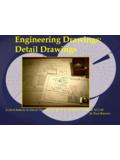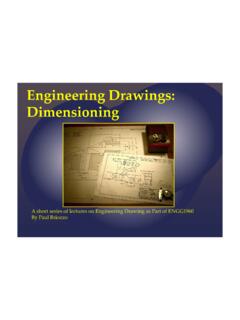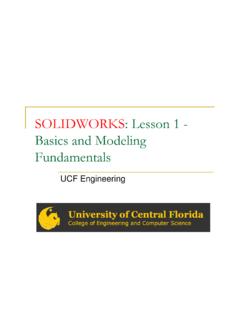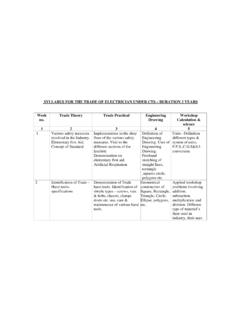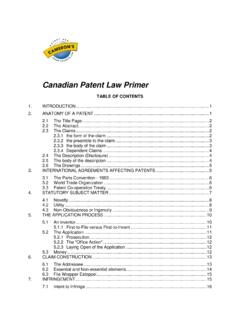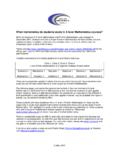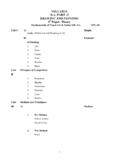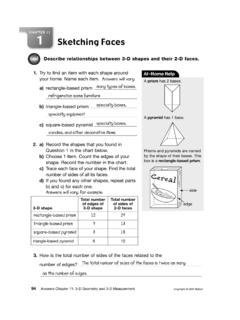Transcription of ANSYS Workbench Guide - University of Sydney
1 MECH3361/9361 Mechanics of Solids 2 1 ANSYS Workbench Guide Introduction This document serves as a step- by- step Guide for conducting a Finite Element Analysis (FEA) using ANSYS Workbench . It will cover the use of the simulation package through the graphical user interface (GUI). More advanced topics will also be briefly covered. Aims and Objectives The purpose of this document is to provide step- by- step instructions on how to use ANSYS Workbench through the GUI. Upon completion, the student should be able to: use symmetry conditions to simplify a typical engineering problem perform a finite element simulation of a typical engineering problem investigate the effects of certain variables that are changed Problem In this Guide , a thin plate with a hole scenario will be investigated, as shown below.
2 Perform a stress analysis by determining: 1. the stress state at points A and B 2. the x- component of stress along line AC 3. the stress state at points A and B with different variables applied: a. changing the size of the hole b. changing the thin plate to a thick block c. increasing the temperature of the plate = 1 MPaxyaux=0uy=02m2mABCF igure 2 Mild Steel FGIHMECH3361/9361 Mechanics of Solids 2 2 Step 1: Launching ANSYS Workbench The ANSYS installation has many packages included. For this tutorial, we will be using ANSYS Workbench . Start menu > ANSYS > Workbench The Workbench Project Window will open.
3 Step 2: Pre- processing (Setting up the Model) Our analysis is a Static Structural analysis. It can be found in the Toolbox on the left, and needs to be added to the Project Schematic by either double clicking it, or dragging it into the pane. MECH3361/9361 Mechanics of Solids 2 3 The Static Structural component and all of its modules will be created. The modules are similar to those in ANSYS MAPDL. They outline the steps that are required to complete a finite element analysis. Engineering Data module is used to define the material properties. Geometry module opens the DesignModeler application, which can be used to import CAD models from other software like SolidWorks or to sketch a new 2D or 3D geometry.
4 Model, Setup, Solution, and Results modules opens the Mechanical application, which can be used to set up and solve the simulation (includes meshing, load and boundary condition applications, solving, and results). Step 2A: Engineering Data Double- click Engineering Data. What you see in this window may differ from the screenshot below. In here, you can add a new material by defining a new material entry for Mild Steel. We want to define the material as an isotropic elastic one. Outline pane > Click here to add a new material > Type Mild Steel Toolbox pane > Linear Elastic > Isotropic Elasticity (double-click) Two yellow boxes will appear in the Properties pane.
5 In ANSYS Workbench , yellow boxes indicate values that must be entered before continuing. In this case, enter in the Young s Modulus (in Pa) and Poisson s Ratio for Mild Steel (find values for these yourself in textbooks or in articles). MECH3361/9361 Mechanics of Solids 2 4 Exit Engineering Data by closing the tab at the top of the window and return to the main Project. Step 2B: Geometry By default, ANSYS Workbench will analyse the problem in 3D. In this problem, we are modelling a plane stress scenario, which allows us to reduce the analysis down to a 2D problem.
6 Static Structural system > Geometry (right-click) > Properties > Properties pane > Advanced Geometry Options > Analysis Type > 2D Enter the DesignModeler application by double- clicking on the Geometry module. DesignModeler is similar to a CAD program. Here you can work with the model and create sketches by clicking on the tabs on the left. The aim here is to draw a square with a circle cut- out on the XYPlane that will become a model of the plate with a hole. To take advantage of the symmetry of the model, we can model just one- quarter of the square and remove a quarter circle on one of the corners.
7 MECH3361/9361 Mechanics of Solids 2 5 To model a 1m x 1m square, with the origin at the bottom left corner: Modeling tab > A: Static Structural > XYPlane (right-click) > Look At Sketching tab > Draw > Rectangle > Draw a rectangle in the graphics window Sketching tab > Dimensions > General > Click on horizontal line of rectangle > Click again to set dimension Details > Dimension > H1 > Type 1 Sketching tab > Dimensions > General > Click on vertical line of rectangle > Click again to set dimension Details > Dimension > V2 > Type 1 Sketching tab > Constraints > Coincident > Click on Y axis > Click on left edge of rectangle Sketching tab > Constraints > Coincident > Click on X axis > Click on bottom edge of rectangle Back to Modeling tab Notice that a new sketch is now
8 Visible under the XYPlane category. This sketch does not constitute a body or surface. We need to define a surface from it. Concept (top menu bar) > Surfaces from Sketches Modeling tab > A: Static Structural > XYPlane > Sketch1 Details pane > Base Objects > Apply Click Generate We now need to create a circle to Boolean subtract from the square. First we need to freeze the square to tell ANSYS not to make any further changes to the square sketch. Tools (top menu bar) > Freeze MECH3361/9361 Mechanics of Solids 2 6 Now go back to the XYPlane and add a new sketch.
9 In this sketch, draw a circle centred at the origin (by using the coincident constraints) and a radius of (by using the general dimension tool). Create a surface from this sketch and generate it. You can now subtract the circle from the square: Create (top menu bar) > Boolean Details pane > Operation > Subtract Target bodies > Select the square > Apply Tool bodies > Select the circle > Apply Generate MECH3361/9361 Mechanics of Solids 2 7 DesignModeler is linked with the Project Window, so no saves are required from this window. However, it s a good idea to save your project at this point from the Project Window.
10 Workbench will save a .wbpj file and a separate folder. Keep these together when moving the project around. Close the DesignModeler window to return to the Project Window. Step 2C: Model Enter the Mechanical application by double- clicking on the Model module. At this point, Workbench should attach the geometry that was made in DesignModeler and make it available in the Mechanical application, where we will complete the configuration of this simulation and solve it. At this point, notice that the Mechanical application has two panes on the left: Outline and Details.
